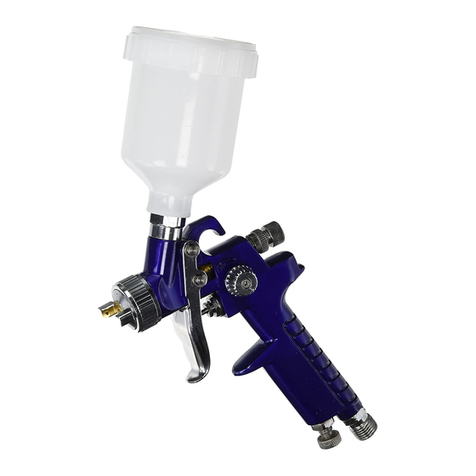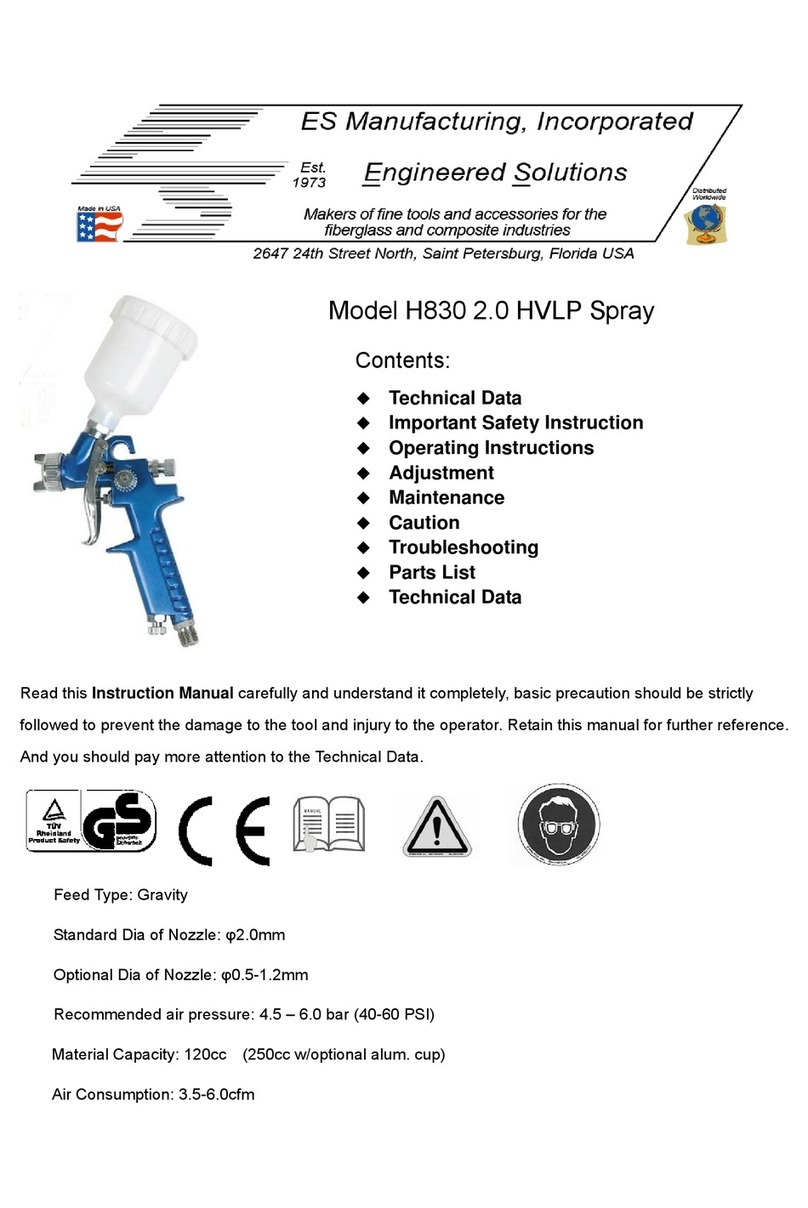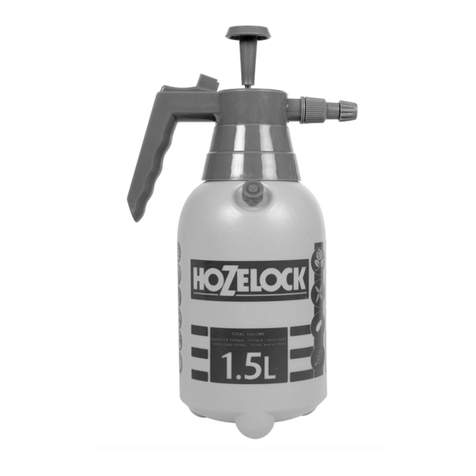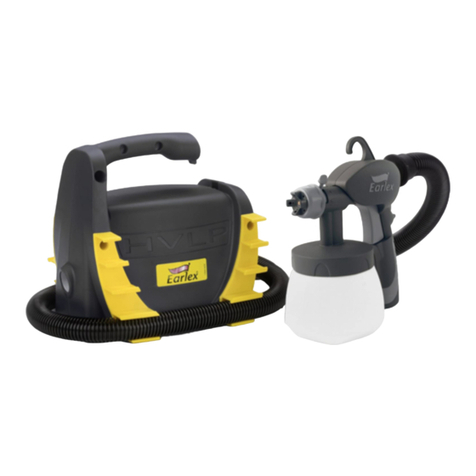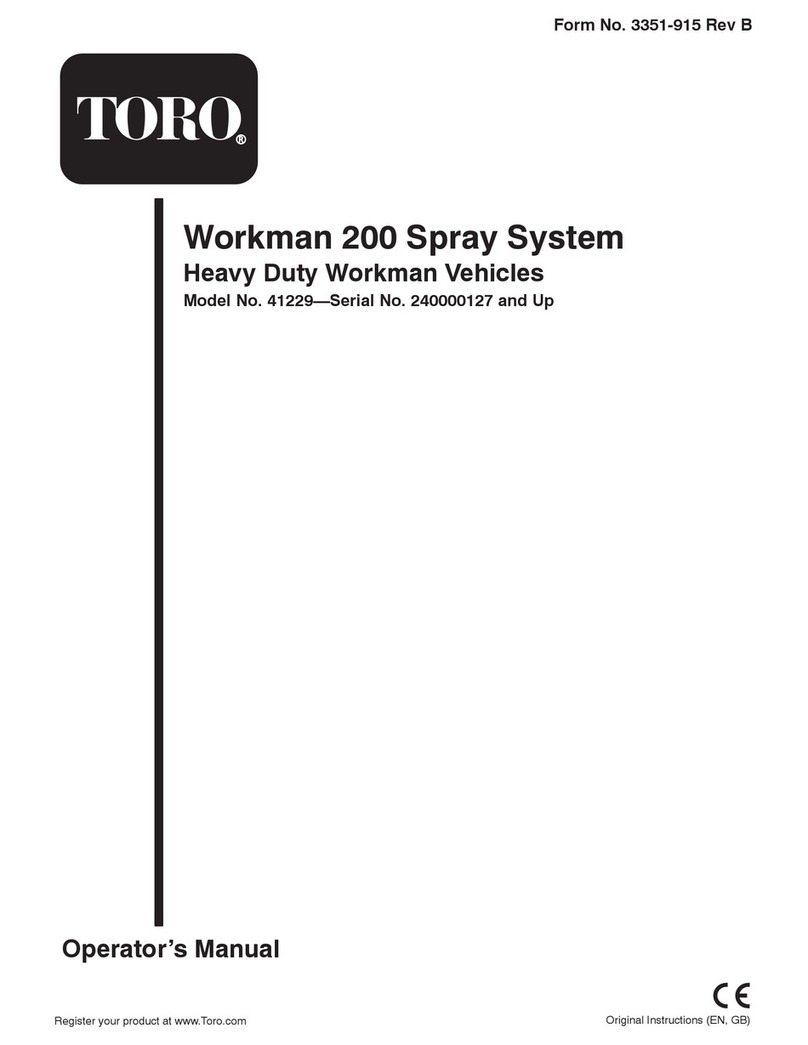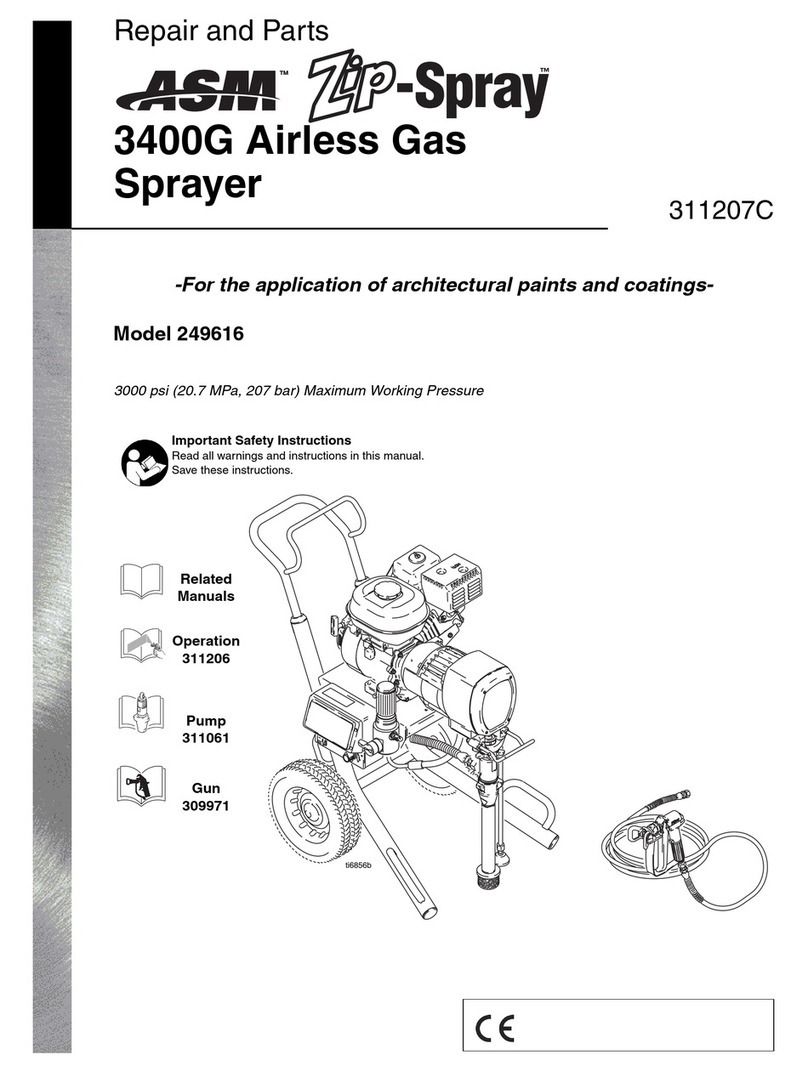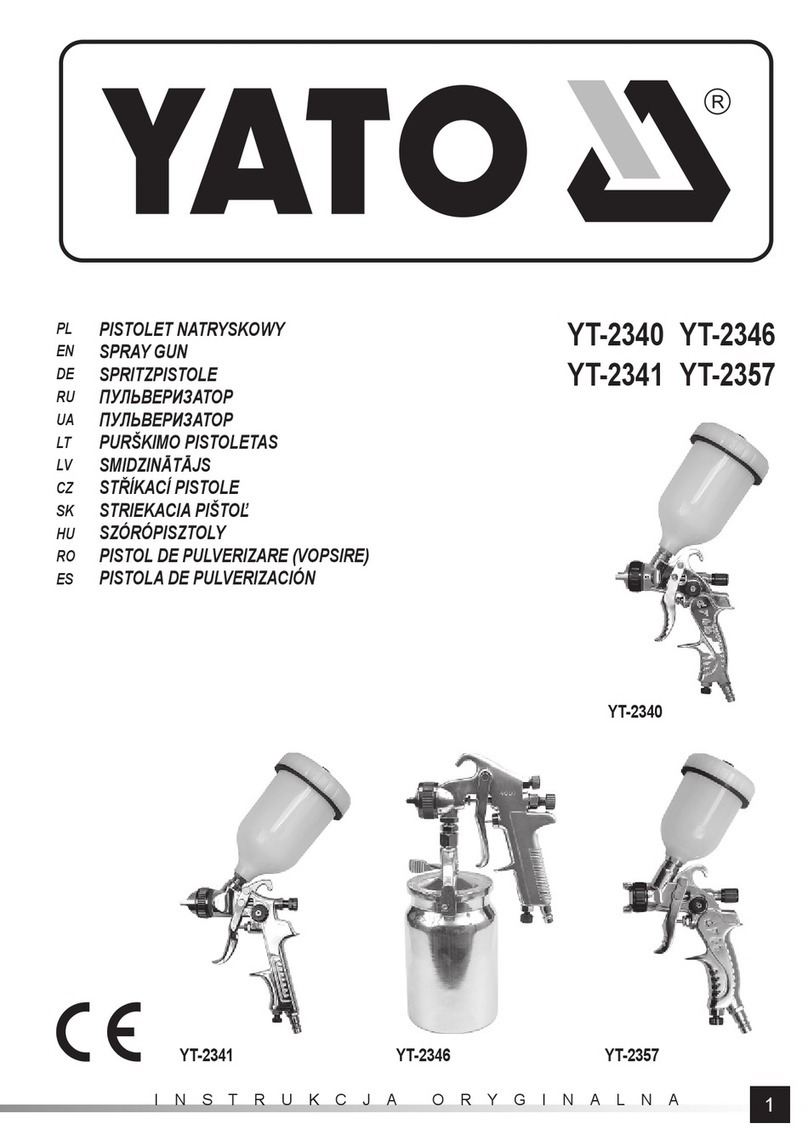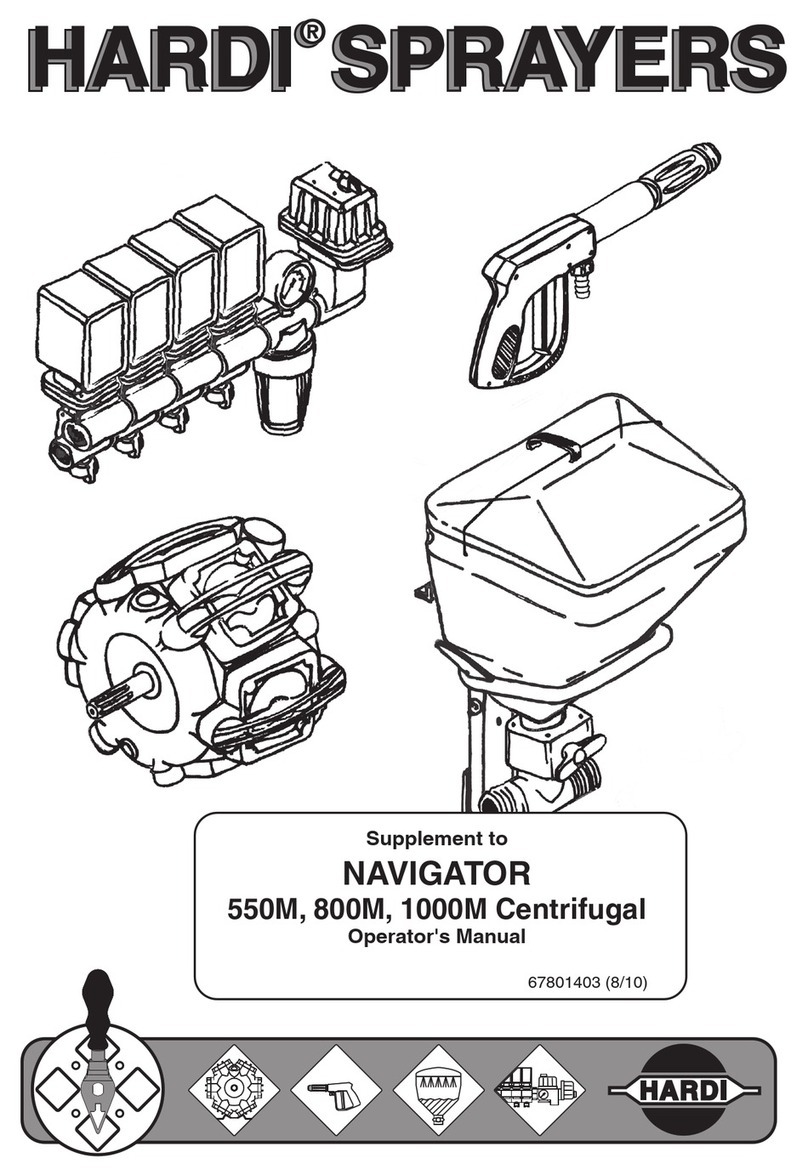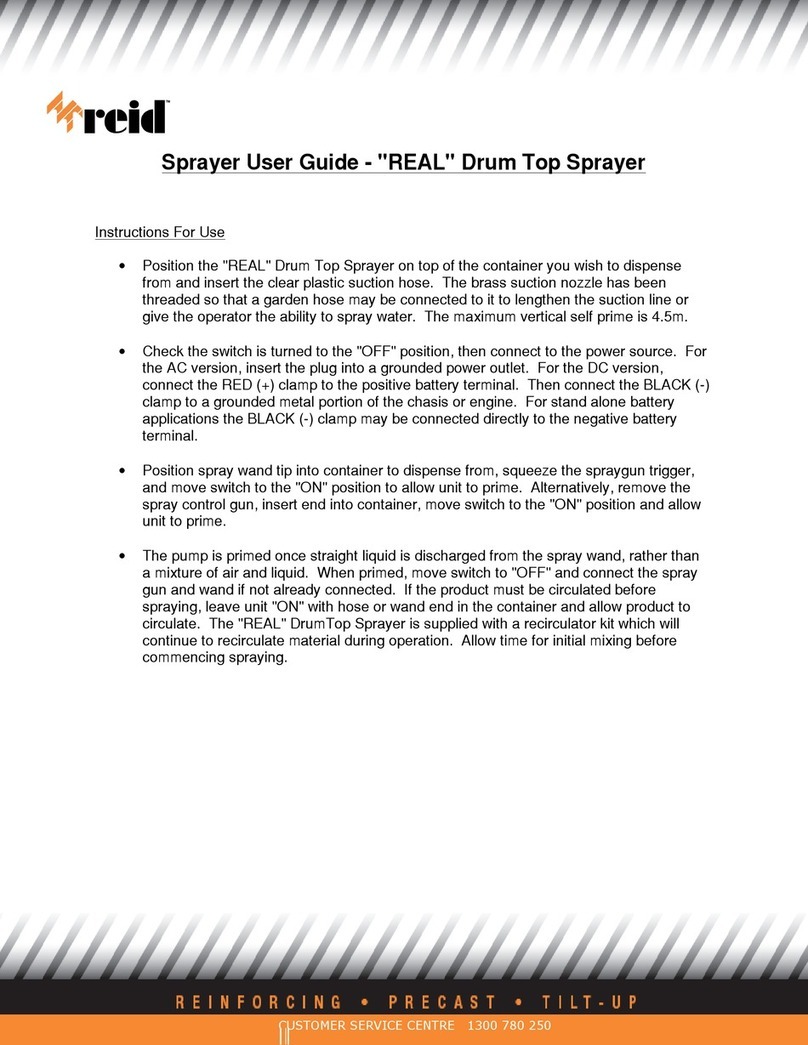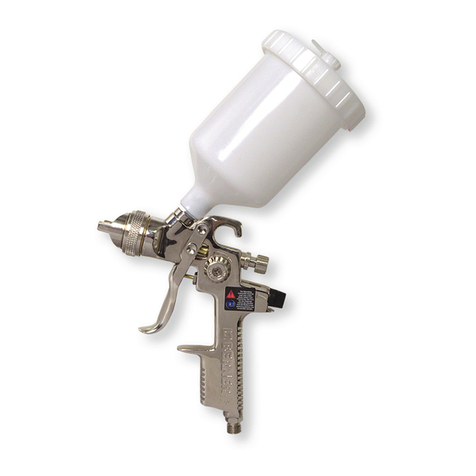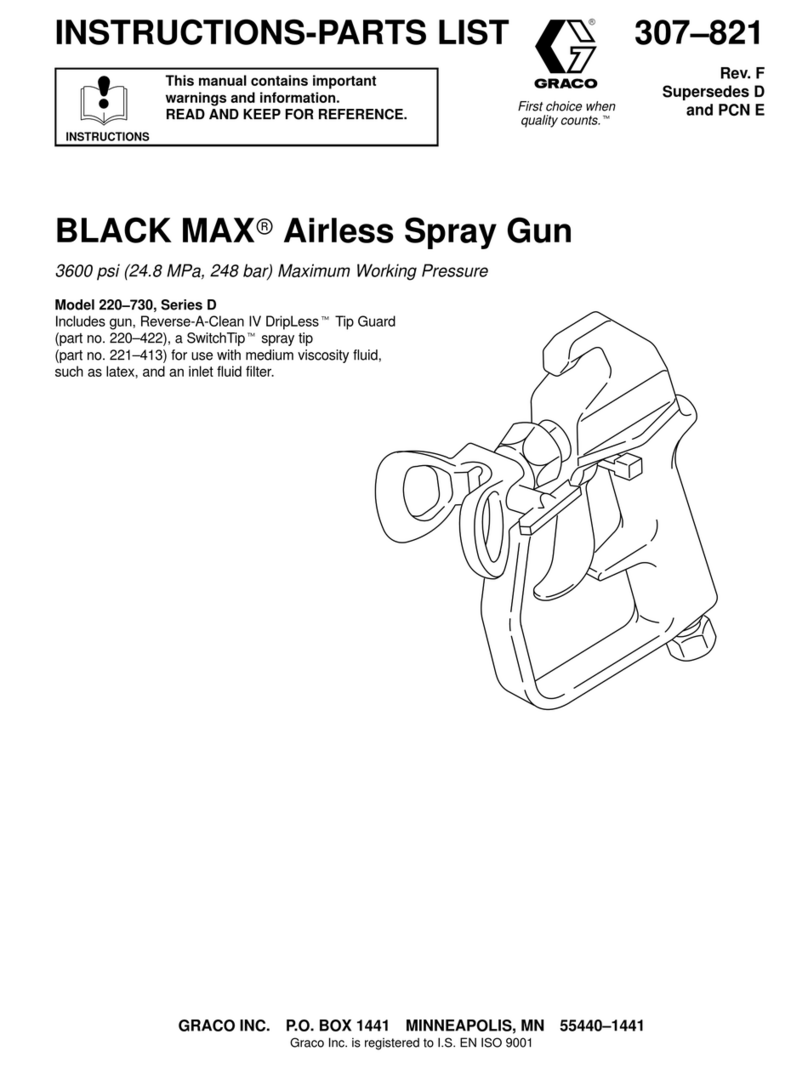ES manufacturing G7701L3.0 User manual

Model No. G7701L3.0
INDUSTRIAL SPRAY GUN
CONTAIN:
Description
Specification and Technical Data
Important Safety Instruction
Instructions for Operation
Maintenance/Storing
Troubleshooting/Repairs
Parts List

- 2 -
Description
A High pressure spray gun is ideal for refinishing cars or a wide variety of home
improvement projects. This high pressure paint sprayer features air, fluid and fan controls to
offer a wide variety of pattern. It is supplied with a 600 cc suction feed Alum. Cup.
Specifications And Technical Data
1. Name of Parts
2. Technical Data
Item No. G7701L3.0
Air Inlet 1/4"
Type of Feed Suction
Standard Dia of Nozzle 2.0mm
Optional Dia of Nozzle
1.8-2.0-2.5mm
Recommended air pressure
3.0-4.0bar (44 – 58psi)
Max. pressure of air
8.3 bar (120psi)
Paint Capacity
1000cc
Avg. Air Consumption
4.2-7.1cfm
Pattern Width
180-280mm

Important Safety Instructions
1.For toxic vapors produced by spraying certain materials can create intoxication
and serious damage to health. Always wear safety glasses, gloves and respirator
to prevent the toxic vapor hazard, solvent and pointing paint coming into contact
your eyes or skin. (see fig 1)
2.Never use oxygen, combustible or any other bottle gas as a power source or
would cause explosion and serious personal injury. (see fig 2)
3.Fluid and solvent can be highly flammable or combustible. Pls Use the tool only in
well-ventilated area, and avoid any ignition sources, such as smoking, open
flames and decrial hazard. (see fig 3)
4.Disconnect tool from air supply hose before doing tool maintenance and during
non-operation, for emerge stop and prevention of unintended operation, a ball
valve near the gun to air supply is recommend.
5.Use clean, dry and regulate compressed air rated at 3.0-4.0bar, never exceed
maximum permissive operating pressure 8.3bar (120psi) (see fig 4)
6.Never use homogenate hydrocarbon solvent, which can chemically react with
aluminum and zinc parts and chemically compatible with Alum. and zinc pats.
7.Never point gun at you and others at any time.
8.Before operating the tool, make sure all the screws & caps are securely
tightened in case of leaking;
9. Before painting, make inspection for free movement of trigger and nozzle to insure tool can operate
well.
10.Never modify this tool for any other applications. Only use parts, nozzles and accessories
recommended and accessories recommended by manufactures.
Instructions For Operation
Preparation
1. After unpacking the product, inspect carefully for any damage that may have occurred during transit.
Make sure to tighten fittings, bolts, etc., before putting unit into service.
2. Thoroughly mix and thin paint in accordance with the paint manufacturer’s instructions. Most
materials will spray readily if thinned properly.
3. Strain material through filter, cheese cloth or a paint strainer.
4. Fill the canister about ¾ full and start the air compressor.
WARNING
DO NOT EXCEED Maximum Pressure of Spray Gun or any other parts in the compressor system.
5. After Connect the gun to air supply, please make sure that the fluid cap, container and air hose have
been connected tightly with spray gun.
6. Set up a piece of cardboard or other scrap material to use as a target and adjust for best spray
pattern.
WARNING
Never aim or spray at yourself or anybody else which would cause serious injury.
7. Test the consistency of the material by making a few strokes on a cardboard target. If material still
appears too thick, add a small amount of thinner. THIN WITH CARE! Do not exceed paint
manufacturer’s thinning recommendations.
1
2
3
4

- 4 -
Adjustment
The desired pattern, volume of fluid output and fine atomization can easily be obtained by
regulating the Pattern Adjusting Knob, Fluid (PAINT) Adjusting Knob and Air Adjusting Knob.
PATTERN ADJUSTMENT: Turning Pattern Adjusting Knob
to the right until tight will make spray pattern round, or
turning left make spray pattern ellipse.
Fluid (PAINT) ADJUSTMENT: Turn the Paint Adjusting
Knob clockwise will decrease the volume of fluid output and
counter-clockwise will increase fluid output.
AIR Volume ADJUSTMENT: Turning the Air Adjusting valve
clockwise will decrease the air volume.
And counter-clockwise will increase the air volume
Operation
1. Begin spraying. Always keep the gun at right angles to the work .
2. Keep the nozzle about 6 to 12 inches from the work surface. Grip the gun keeping perpendicular
with spraying area then move it parallel for several times, Stopping gun movement in mid-stroke will
cause a build up of paint and result in runs. Do not fan the gun from side to side while painting. This
will cause a build-up of paint in the center of the stroke and an insufficient coating at each end.
3. Trigger the gun properly. Start the gun moving at the beginning of the stroke BEFORE SQUEEZING
THE TRIGGER and release the trigger BEFORE STOPPING GUN MOVEMENT at the end of the
stroke. This procedure will blend each stroke with the next without showing overlap or unevenness .
4. The amount of paint being applied can be varied by the speed of the stroke, distance from the surface
and adjustment of the fluid control knob.
5. Overlap strokes just enough to obtain an even coat.
NOTE:
Two thin coats of paint will yield better results and have less chance of runs than one heavy layer.
6. Use a piece of cardboard as a shield to catch overspray at the edges of the work to protect other
surfaces.

- 5 -
Maintenance
Incomplete cleaning could cause function failures and a degradation of the fan form.
1. Remove any remaining paint by pouring it into another container.
2. Disassemble the spray gun making sure to remove the needle before disassembling the nozzle to
avoid damage to the housing of the nozzle closure.
3. Clean all the paint passages and the nozzle. Clean the other components using a brush soaked in
solvent.
4. Reassemble the spray gun and spray a small quantity of solvent to eliminate all the residues in the
paint passages.
ARNING:
NEVER USE METAL OR OTHER OBJECTS THAT COULD DAMAGE THE HOLES IN THE NOZZLE AND CAP. NEVER
IMMERSE THE SPRAY GUN COMPLETELY IN SOLVENT. NEVER USE COMPONENTS OR PARTS THAT ARE NOT
MANUFACTURER ORIGINALS.
Storing
When not using spray gun, turn the fluid adjustment knob counter-clockwise to open
which will reduce spring tension on needle fluid tip.
Spray gun MUST BE well cleaned and lightly lubricated.

Trouble shooting
Symptom Problems Solution
Fluttering or
spitting
1. Material level tool low.
2. Container tipped too far.
3. Loose fluid inlet connection.
4. Loose or damaged fluid tip/seat.
5.
Dry or loose fluid needle packing
nut.
6. Air vent clogged
1. Add material into container.
2. Hold more upright.
3. Tighten.
4. Adjust or replace.
5. Lubricate and or tighten.
6. Clear vent hole.
Pattern is arc.
1. Worn or loose Fluid nozzle.
2. Material build up on Air cap.
1. Tighten or replace Fluid nozzle.
2. Remove obstructions from holes,
but don’t use metal objects to clean
it.
Pattern is not
Evenly spread.
1. Material build up on Air cap.
2. Fluid nozzle dirty or worn.
1. Clean or replace Air cap.
2. Clean or replace Fluid nozzle.
The
center
of Pattern
too narrow.
1. Material too thin or not enough.
2. Atomization air pressure too
high.
1. Regulate material viscosity.
2. Reduce air pressure.
Pattern
width of
fan-sharp is not
enough.
1. Material too thick.
2. Atomization air pressure too low.
1. Regulate material viscosity.
2. Increase air pressure.
Air leaking from
air cap without
pulling trigger
1. Sticking air valve stem
2. Contaminate on air valve or seat
3. Worn or damaged air valve or
seat
4. Broken air valve spring
5. Bent valve stem
1. Lubricate
2. Clean
3. Replace
4. Replace
5. Replace
Fluid leaking from
packing nut
1. Packing nut loose
2. Packing worn or dry
1. Tighten, but do not restrict needle
2. Replace or lubricate (non-silicone
oil)
Excessive
overspray
1. Too high atomization pressure
2. Too far from work surface
3. Improper stroking (arcing, gun
motion too fast)
1. Reduce pressure
2. Adjust to proper distance
3. Move at moderate pace, parallel
to surface.
Will not spray
1. No pressure at gun
2. Fluid control not open enough
3. Fluid too heavy
1. Check air lines
2. Open fluid control
3. Thin fluid or change to pressure
feed system.

- 7 -
Parts List
If you need spare parts of this model, pls feel free to contact us or the distributor where you
bought this tool. Thank
No Description No Description No
Description
1 Air Adj. Screw 19 Ring 37 Nut
2 Air Adj. Knob 20 Snap Retainer 38 Cup Lid
3 O-ring(3.15*1.8) 21 Pattern Needle 39 Cup Lid Washer
4 Washer 22 Snap Retainer 40 Paint Tube
5 Air Valve Spring 23 Trigger 41 Suction Cup
6 Air Inlet Valve 24 Trigger Level 42 Pin Set
7 Air Inlet Plug 25 Nozzle 43 Pin
8 Gun Body 26 Rounded Nut 44 Switch Screw Seat
9 Washer 27 Steel Ball 45 Sealing Washer
10 Needle Housing Fluid 28 Nut 46 Switch Seat
11 O-ring(8.7*1.85) 29 Washer 47 Air Valve
12 Needle 30 Atomization 48 Switch Spring
13 Spring Core 31 Paint Inlet Plug 49 Washer
14 Needle Spring 32 Butterfly Nut 50 Sealing Washer
15 Fluid Adj. Screw Plug 33 Paint inlet Nozzle 51 Direction Screw
16 Pattern Adj. Screw Plug 34 Nut 52 Tool Wrench
17 Pattern Adj. Screw Seat 35 Gravity Cup Lid 53 Air Inlet Nut
18 Spring 36 Gravity Cup 54 Air Hose Plug
Table of contents
Other ES manufacturing Paint Sprayer manuals
